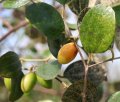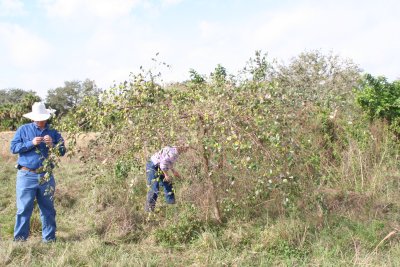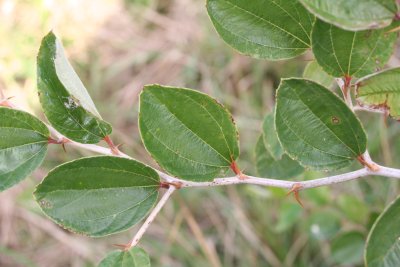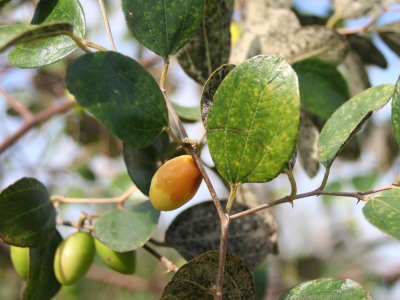Indian Jujube (Ziziphus mauritiana): A Weed to Watch in Florida Pastures

Indian jujube (Ziziphus mauritiana), also known as chinee tree, is a large shrub or small tree (Figure 1) native to southern Asia and eastern Africa. It has spread to Queensland, Australia, where it is considered a Class 2 (plants are established and have, or could have, an adverse economic, environmental, or social impact; the management of these pests require coordination and are subject to control programs by agencies and landowners) invasive plant (Anonymous 2005). According to the Atlas of Florida Vascular Plants, it is present in Miami-Dade County (Wunderlin and Hansen 2008). The University of Florida Herbarium has also identified specimens located in Lee County. Recently, several plants were identified as Indian Jujube in a pasture in Glades County, near Lakeport. This indicates that this plant may be more widespread than is indicated by vouchered herbarium specimens.
Plant Identification
This woody plant is densely branched with zigzag branches (Figure 2). Branches typically have a leaf and a thorn at each angle. Leaves are ovoid, glossy green above and nearly white underneath (Figure 3). The major veins in the leaves are nearly parallel (Figure 3). Over time, the leaves typically become infested with a fungus, causing the leaves to have a yellow-mottled appearance above and turn black below (Figure 4). Flowers are small and inconspicuous, greenish-white, and emit an unpleasant odor. The fruits are edible, and are similar in shape and size to the native hog plum (Figure 5). The fruits are initially green, but have a yellow to pale orange color when ripe. Seeds are enclosed within a woody endocarp.
Habitat and Ecology
In most cases, Indian jujube is restricted to the drier tropics. During the dry season, plants typically lose their leaves, but rapid regrowth occurs at the onset of the rainy season. According to researchers in Australia, it is capable of growing on a wide range of soil types among various vegetation groups. However, Indian jujube prefers open habitats and does not survive well under the canopy of other trees (Anonymous 2005).
Fruit and seed production is highly variable among plants. However, plants less than 1.5 m tall typically do not produce fruits (Grice 1998). Large plants (>3 m tall) are capable of producing 5,000 fruits (Grice 1998). Plants in the 1.5 to 2.0 m range produced an average of 2 to 7 fruits per plant. Plants at 2.0 to 3.0 m produced an average of 19 to 54 fruits per plant (Grice 1998).
Seedling survival in Australia is extremely low, with 0.002 to 3.7% survival. Grice (1998) contends that the critical phase of Indian jujube's life cycle occurs in the first dry season following germination. It is during the dry season when most seedlings die, and the number of surviving seedlings is governed by the length of the dry season.
Spread
Dispersal of Indian jujube is primarily through animals. In large infestations within cattle grazing areas in Australia, an average of 17.5 fruits (woody endocarps) were recovered from cattle dung piles (Grice 1998). Seeds were also dispersed by feral swine and birds in Australia, which is the likely means of dispersal in Florida.
Control
There are several methods to control Indian jujube including cut-stump, basal bark, and foliar sprays. Basal bark and cut-stump applications of Cleanwave (fluroxypyr + aminopyralid) at a 10% solution (in oil) or triclopyr-ester (Garlon 4 Ultra, Remedy Ultra, Tahoe 4, etc.) at a 5% solution (in oil) have been effective in Australia. Foliar sprays of a 3% v/v triclopyr-ester or glyphosate at the same concentration have also been effective.
Although Indian jujube is not wide-spread in Florida, it is important that we recognize this invasive plant early. This is fortified by the spread and invasion of this plant in Australia, where it is causing harm in various ecosystems under a climate that is very similar to Florida's.
Literature Cited
- Anonymous. 2005. Chinee apple. Natural Resources and Water Fact Sheet. Queensland, Australia. Available online: http://www.nqccs.com.au/library/weeds/chinese_apple.pdf .
- Grice, A. C. 1998. Ecology in the management of Indian jujube (Ziziphus mauritiana). Weed Sci. 46:467-474.
- Wunderlin, R. P., and B. F. Hansen. 2008. Atlas of Florida Vascular Plants (http://www.plantatlas.usf.edu/).[S. M. Landry and K. N. Campbell (application development), Florida Center for Community Design and Research.] Institute for Systematic Botany, University of South Florida, Tampa.





